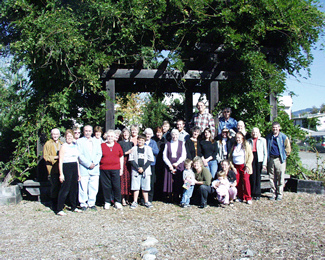
Saint Francis in the Redwood Episcopal Church
66 East Commercial, Willits, Mendocino County, California
(707) 459-3066
email: stfranciswillits@hotmail.com
Service at 10 AM Sunday

Much of our congregation is gathered under the arbor in our garden. The arbor is a memorial to a much beloved young woman who was tragically killed in an automobile accident.

The garden before construction. Looking across US Highway 101 (running right to left) and Commercial Street. You can barely see our present church behind the red car, and the mural of Saint Francis on the wall facing the garden.
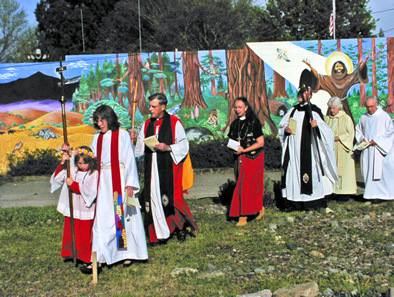
The Beginning. The official groundbreaking procession. Rose our youngest acolyte could barely hold the cross with Betsy our total ministry priest assisting her. Jerry Lamb our beloved and now retired bishop. Debbie Royals a special friend and priest who said a Native American ceremony. Barry Beisner our awesome current bishop holding the shovel. Mary Fisher our beloved retired priest. Harry Allagree our regional missioner. The rest of the congregation and many well wishers are following.
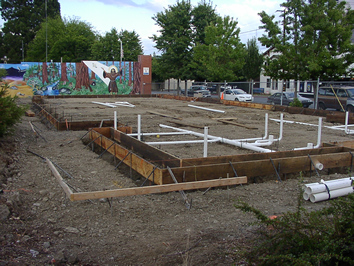
You begin a church with a strong base. Note the Saint Francis mural and our church in the background.
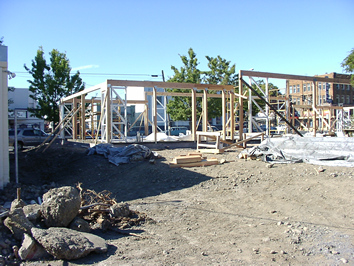
The skeleton of the church is well underwway. This will be what is called "straw bale infill", the straw bales do not support the church, but are filled in later, much like other insulation is added later. The difference is that the straw bales are strong and rigid themselves, adding to the structural strength of the walls, as well as much of the siding both inside and out.

One of the gable end walls of the church with Saint Francis appearing to hold it all up with a smile. This mural was painted years ago by a member of our congregation, Malaki Schindel, when he was only 18. He is an amazing artist and has gone on to paint a number of murals throughout the county since then.
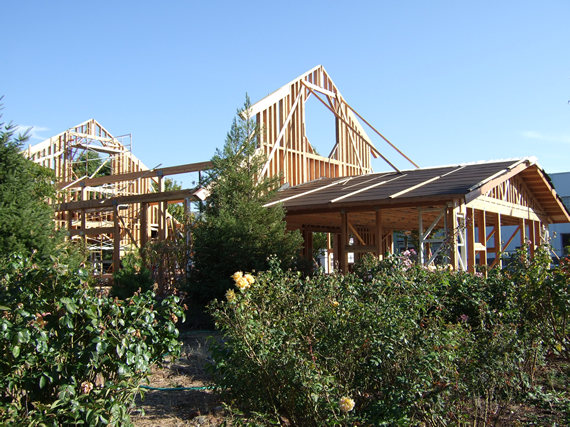
A view through the remains of the garden at the construction. We hope to reclaim parts of the old driveway so that the net loss to the garden will be minimized.

Hoisting the trusses into place. Each one weighs over a thousand pounds. Some people watching from in front of the Noyo Theater. The whole town has enjoyed the spectacle of its construction and you can find people checking on the progress day and night. Tom Allen our builder is great. They decided that they could save us some money by making the trusses themselves. They are beautiful.

The day comes that two semi-trailers full of straw arrive.

It is already pushing November so we have to get the bales into the ends of the church for protection from rain, which can come at any day in the coastal mountains. These students from San Hedrin High up the street helped the men folk in the congregation to store the small mountain of bales.

Both ends of the church were packed to the rafters with straw bales by the time we were finished. I am in the back in the blue shirt. This is rice straw from the Sacramento Valley - the best straw for building. This is because it has a high silica content that gives it a little more strength but more importantly makes it more resistant to rotting or molding. We bought bales that are highly compressed and of standardized size for easy construction.
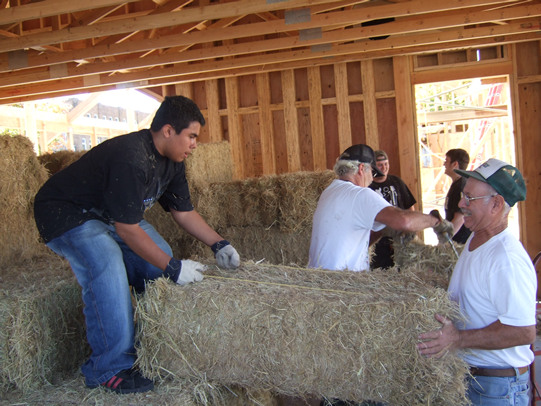
These bales weighed over 100 pounds each! Everyone built muscles this day. Parisioner Dick Perrone is handing off a bale to be stacked.
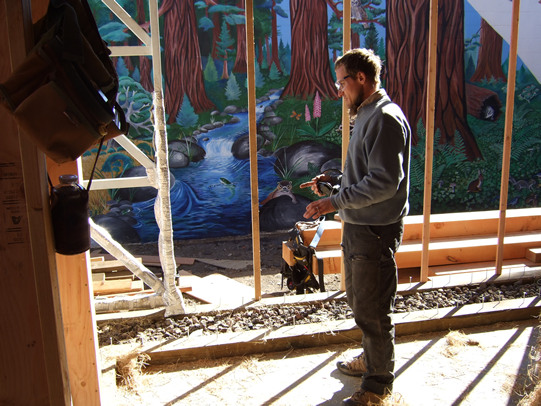
Sam Sincercia, our straw boss, is figuring out how to stack the bales most efficiently. The bales sit on the 4x4s and the gravel between them is additional protection from moisture. The bales will be stacked against the vertical 1x2s, and when the wall is finished, 1x2s will be added on the inside wall as well. Strings are then laced through each bale and tied to the 1x2s to securely hold them in place. The wrapped zig-zaggy thing on the left is anti-earthquake metal stiffening, since the Mayacama fault runs right through the middle of town not far away.

In the early days of straw bale construction people would drive metal rebar through the bales to hold them together. Then someone realized that metal condenses moisture - very bad for straw! That is why wood 1x2s now hold them together. Even the anti-earthquare metal stiffening must be wrapped with insulating foam to protect the straw. Here Charles Senter explains to Greg Schindel that every square inch of metal must be insulated.
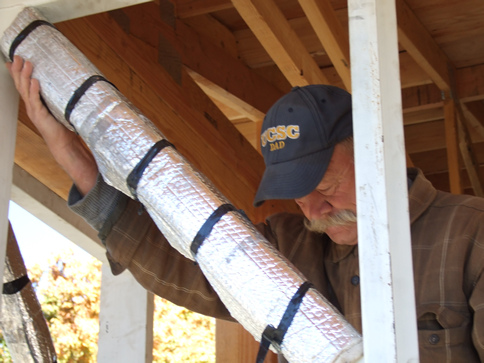
Greg Schindel being very careful that the metal is fully covered. It probably took the efforts of eight people over 40 hours of work to get these metal brackets properly insulated!
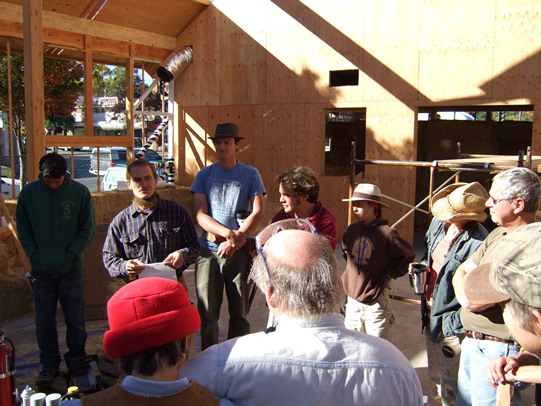
To put the staw bale walls up we had a Bale Raising weekend where about 50 people in the area showed up to help. This is the orientation meeting with the five straw bale experts explaining the process. They were surprised and delighted by the progress - we almost finished all the walls!
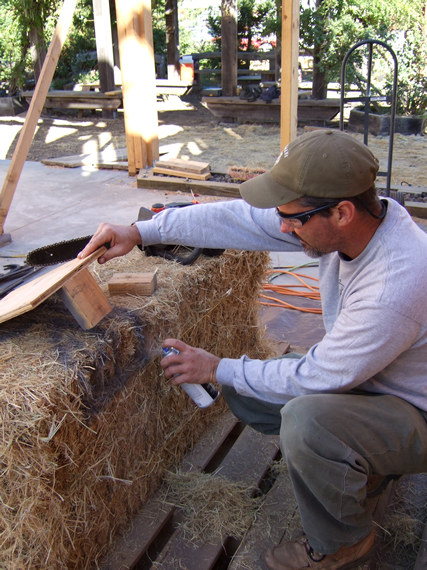
The weekend's progress was all the more amazing because nearly every bale had to be shaped and custom fitted into the walls. This often required complex measuring and then painting each bale with areas that had to be cut away with a chain saw.

Cutting bales with chainsaws. Generally one wears protective masks because of the dust, but this was actually the day before when they were experimenting with the best techniques.
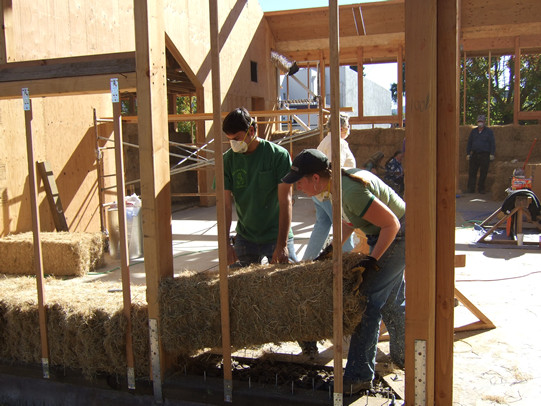
Placing the bales in the wall. Note how snugly they are being placed against the 1x4s. There are nails sticking up from the footing to help keep the bales in place. The couple are Gabe Madrigal, the number two staw boss, and his wife Holly, who sits on the City Council and was working hard this day. They also live in a straw bale house they built.
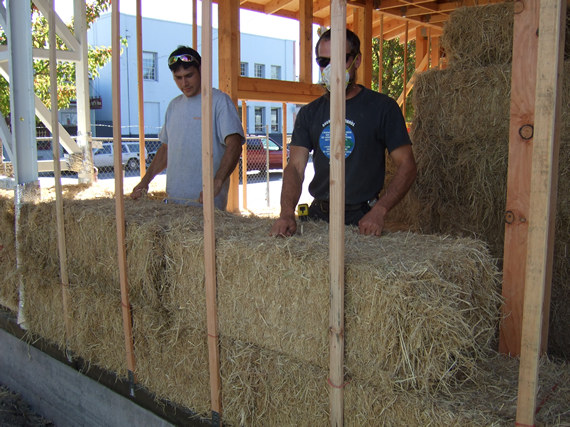
Gabe and Sam placing the second row of bales. Any gaps or holes between the bales will be stuffed later.

A typical working scene for the weekend. Michael Hackelman in the foreground is working full time to keep the chain saws running. There must be a better way to cut straw! Sometimes the chainsaws would almost immediately clog. Running a chain saw for a half hour without clogging was considered a feat! Another City Councilman Ron Ornstein cutting bales in the middle. A parisioner on the left, Ann Maxwell, worked all day cutting hundreds of lengths of twine to bind each bale into place.

Another working scene. In the center in white is our head acolyte, Ben Malugani, re-sizing bales to fit into the walls. The bales in the foreground are stacked about as high as they can go!
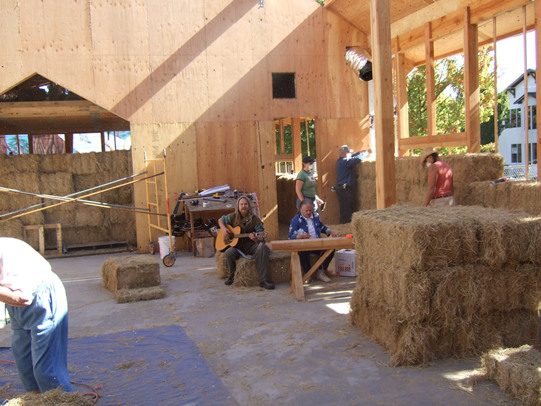
Malakai Schindel takes a break from construction to provide music to work by, traditional for a straw bale party. You can just see John Thorslev in the background stringing bales to the outside 1x2s for later tying off when the inside 1x2s are built.
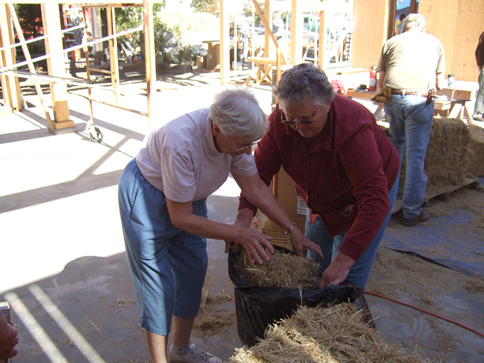
Baled straw is quite fire resistant but loose straw is quite a fire threat, as well as a source of irritating dust. Another full time job was bagging up loose straw, performed by two of our parishioners Claudia Smith-Hill and Marlene Brown. We ended up with over 40 huge bags of loose straw which the community garden was most grateful for.

I love this picture, one of my favorites. xxx, a teenager from the next town Ukiah, worked hard all weekend. Here she is stringing twine through the bales and around the 1x2s. Saint Francis is cheering her on!

Here Gabe is making sure the walls are plumb (level). The use of the oversized baseball bat will become clearer in the next picture. Note that the inside 1x2s are in place and you can just see some of the red twine ends dangling loose waiting to tie the bales securely in place.

Colin xxx is another master straw bale builder who came to our rescue to help finish the walls (while in the process of finishing his own straw bale house!). Here he is hammering the bales into a smooth and level wall. Note the level in the foreground, it is a two-step process. While all of this is happening the regular crew that is building the rest of the church is still making progress. It is a tall church and they get a lot of use out of the blue high-lifter.
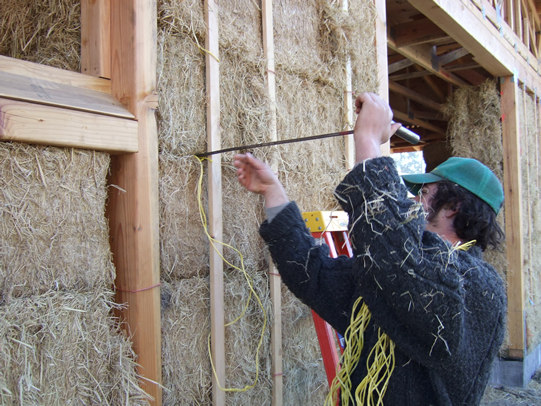
As careful as everyone tried to be to thread twine through each straw bale, there were lots of places where this didn't happen. No problem! This huge needle wielded by xxx threads twine where it is missing. The needle actually has two eyes, one for each end of the twine, and you can just see that it is already looped around the outside 1x2.

For various reasons there would be holes or crevices in the straw bale walls. Often the space between bales would have gaps. Filling those gaps was another job that we parisioners performed to save money. The process is pretty low tech - you would find a short stick that was around 1"x1" and use it to push handfuls of hay into the gaps. Here I am stuffing hay into the gaps while Greg Schindel is securing the bales. He is doing this the "traditional way" twisting a nail around the twine, which takes up any slack, thus binding the bales to the 1x2 wood. He then drives the nail into the bale to secure it.

Hammering a nail into straw did not seem all that secure, and often led to hammered fingers because the straw is so flexible. We tried other ways to better secure the nail. Dick Perrone found the best solution, and the easiest. Once twisted tight around the twine, rather than hammering the nail into the bale, you could tap it until it was wedged between the straw bale and the 1x2, i.e., parallel to the face of the wall but recessed behind the 1x2.
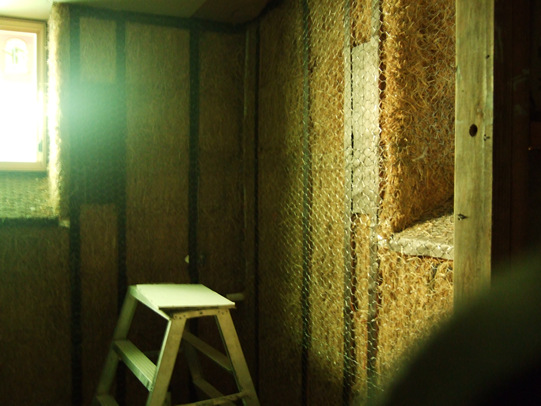
Here we are preparing the walls for plastering. The walls all have chicken wire tightly bound to the bales. This only happens after all the windows and doors and any interior partitiions (with attached sheetrock) are installed. Today is December 11, and we expect this finishing to begin this week.
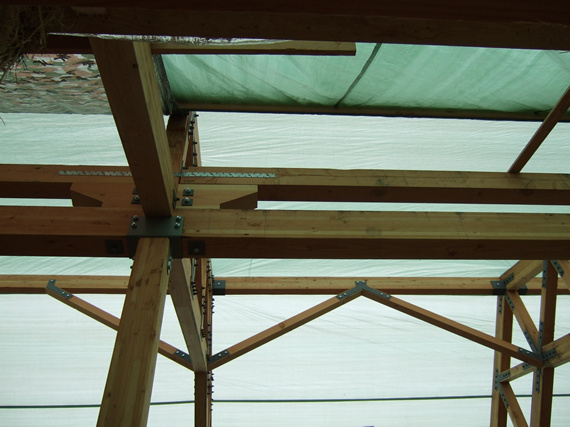
Other Thoughts: How have we kept the straw dry well into December, after several rainstroms? Tarps. All the outside walls are fully tarped, not only to protect the straw, but also to make life easier for everyone working through the Winter. The whole roof for the center portion of the church was terribly late in coming, and so the center roof was covered with poly tarps as well until two weeks ago. It has caused a lot of anxiety over the weather but fortunately all the rain that came in the interim had no wind attached. But I must say those tarps were beautiful! So translucent and slightly rippling in in the wind. Lovely while it lasted.
Straw Bale and Rammed Earth Buildings
| top |
|
Bill and Betsy Bruneau
18001 Shafer Ranch Road, Willits, CA 95490-9626 USA
Website: www.bbruneau.com
Copyright 2007-2018, William Bruneau